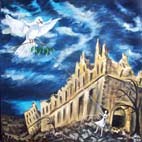Among the more powerful works in Legato this year is this sculpture, "RED", by Anna Maria Corsi. She writes:
Carissimi genitori,... se questo è un uomo...
Storia di un reduce dal lager...
L'opera ad una prima lettura potrebbe esser difficilmente compresa.
E' un assemblaggio di vari oggetti, ma che nel insieme vuole rappresentare la tragicità della guerra e in particolare dei prigionieri dei lager tedeschi.
Mio nonno paterno si chiamava Lorenzo Corsi, fu fatto prigioniero in Grecia nelle ultime battaglie prima dell'Armistizio del 8 settembre, (era nel reparto "Sanità") fu deportato direttamente in Germania nella Westfalia, dove visse in uno dei campi sterminio.
Riusci a scappare insieme ad un suo amico di Veroli con l'aiuto di un soldato austriaco che era di guardia e tornarono in patria dopo la fine della guerra, camminando tutto a piedi, per paura di essere ritrovati e fucilati, non sapendo che la guerra fosse finita.
Fu un soldato cosi detto "IMI" (internati militari italiani) ovvero quelli che in maggioranza preferirono la prigionia nei lager tedeschi al passaggio dalla parte nazi-fascista.
la gavetta e la lettera che scrisse dal campo ai genitori che si trova sull'opera erano le sue.
Si può vedere inciso la parola "RED" (fu di fede socialista),
il filo spinato è il coloro rosso perché rappresenta il sangue versato dai milioni di morti di diversa fede politica, religiosa ed etnica,
dai suoi racconti, ricordo che diceva il camice era l'unico indumento che lui indossava e mangiava soltanto neve e bucce di patate.
non ricordo se fosse di colore nero, ma qui vuole rappresentare inevitabilmente il colore della morte.
dedicato a mio nonno,
Anna Maria Corsi.

Dear Parents, ... if this is a man ...
Story of a survivor of the camps ...
The work at first sight is not easily understood.
It is an assemblage of different objects, but the whole is meant to represent the tragedy of war and in particular the prisoners of German concentration camps.
My paternal grandfather's name was Lorenzo Corsi. He was taken prisoner in Greece in the last battles before the Armistice of September 8, (in the "Health Department") and was deported directly to Germany in Westfalia, where he lived in one of the extermination camps.
He managed to escape, along with his friend from Veroli, with the help of an Austrian soldier who was on duty. He returned home after the war, walking all the way for fear of being discovered and shot, not knowing that the war was over.
He was a soldier so-called "IMI" (Italian military internees) or those who preferred interment in the German prison camp to becoming a Nazi-Fascist.
He was a soldier when he wrote the letter to his parents which is in this work.
You can see the word "RED" (he was a believer in socialism),
The barbed wire is red because it represents the blood shed by the millions (who were) of different political beliefs, religions and ethnicities.
From his stories, I remember him saying the shirt was the only garment he wore and ate only snow and potato peelings. I do not remember if it was black, but here I have chosen black to represent the color of death.
dedicated to my grandfather....
Anna Maria Corsi.





